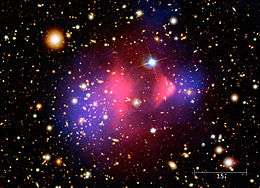Dark star (dark matter)
A dark star is a type of star that may have existed early in the universe before conventional stars were able to form. The stars would be composed mostly of normal matter, like modern stars, but a high concentration of neutralino dark matter within them would generate heat via annihilation reactions between the dark-matter particles. This heat would prevent such stars from collapsing into the relatively compact sizes of modern stars and therefore prevent nuclear fusion among the normal matter atoms from being initiated.[1]
Under this model, a dark star is predicted to be an enormous cloud of hydrogen and helium ranging between 4 and 2000 astronomical units in diameter and with a surface temperature low enough that the emitted radiation would be invisible to the naked eye.[2]
In the unlikely event that dark stars have endured to the modern era, they could be detectable by their emissions of gamma rays, neutrinos, and antimatter and would be associated with clouds of cold molecular hydrogen gas that normally wouldn’t harbor such energetic particles.[3][2]
References
- ↑ Spolyar, Douglas; Freese, Katherine; Gondolo, Paolo (Jan 2008). "Dark matter and the first stars: a new phase of stellar evolution". Physical Review Letters. arXiv:0705.0521
 . Bibcode:2008PhRvL.100e1101S. doi:10.1103/PhysRevLett.100.051101.
. Bibcode:2008PhRvL.100e1101S. doi:10.1103/PhysRevLett.100.051101. - 1 2 Siegel, Lee (2 Dec 2007). "Were the first stars dark?" (Press release). University of Utah.
- ↑ Moore, Nicole (2 Dec 2007). "Dark matter powered the first stars, physicists speculate" (Press release). University of Michigan.
Gamma-rays, particles called neutrinos or antimatter could be tell-tale signs
- Freese, Katherine; Gondolo, Paolo; Spolyar, Douglas (July 2007). "The Effect of Dark Matter on the First Stars: A New Phase of Stellar Evolution". Proceedings of First Stars III. Santa Fe, New Mexico. doi:10.1063/1.2905656.
- Spolyar, Douglas; Freese, Katherine; Gondolo, Paolo (2007-12-03). "Dark matter in newborn universe doused earliest stars". Physical Review Letters. Reported in Physorg.com. Retrieved 2007-12-04.
- Freese, Katherine; Bodenheimer, Peter; Gondolo, Paolo; Spolyar, Douglas (2008). "Dark Stars: the First Stars in the Universe may be powered by Dark Matter Heating". arXiv:0812.4844
 [astro-ph].
[astro-ph].
